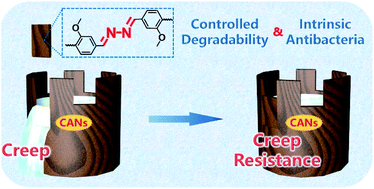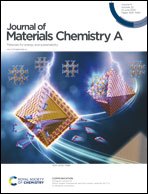Dihydrazone-based dynamic covalent epoxy networks with high creep resistance, controlled degradability, and intrinsic antibacterial properties from bioresources†
Abstract
Covalent adaptable networks (CANs) provide a promising approach to solve the issue of recycling thermosets due to their dynamic cross-linked networks. However, CANs are susceptible to creep at relatively low temperatures, and their chemical stability is also inevitably doubtful. Here, we designed novel dihydrazone CANs by cross-linking a dihydrazone-containing epoxy monomer, which was synthesized from the condensation of a lignin derivative vanillin and hydrazinium hydrate, followed by a reaction with epichlorohydrin. Besides the excellent malleability and reprocessability, the dihydrazone CANs exhibited a high initial creep temperature of ∼105 °C, which was ascribed to the superior stability of the hydrazone bond at around 100 °C and favorable hydrazone exchangeability at elevated temperatures. Meanwhile, the degradation of the dihydrazone CANs exhibited temperature, solvent, and acidity dependence. Moreover, on account of the high antibacterial properties of the hydrazone bond, the CANs presented a high killing rate (95.8%) for Gram-negative bacteria (E. coli). Thus, this work discloses an effective dynamic covalent motif for the development of CANs with excellent dimensional stability, chemical resistance, and intrinsic antibacterial properties.



 Please wait while we load your content...
Please wait while we load your content...